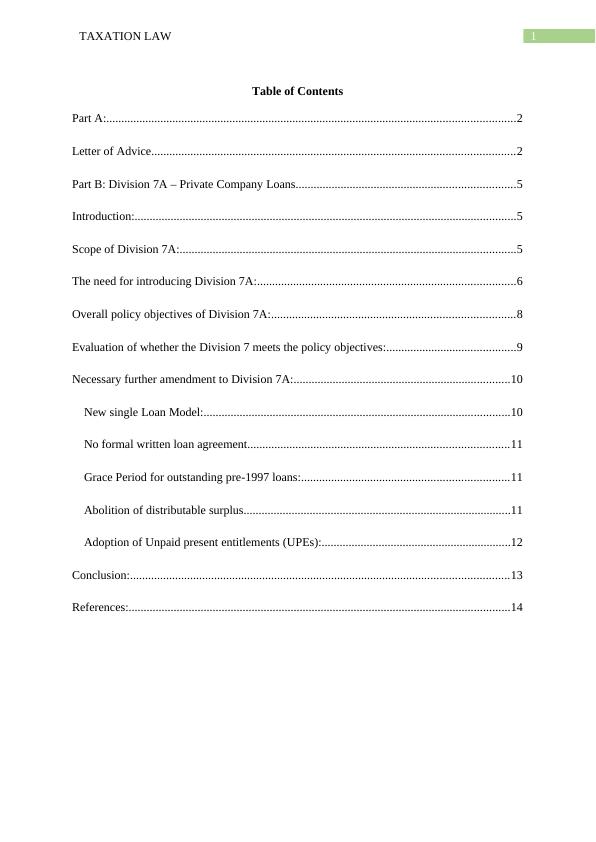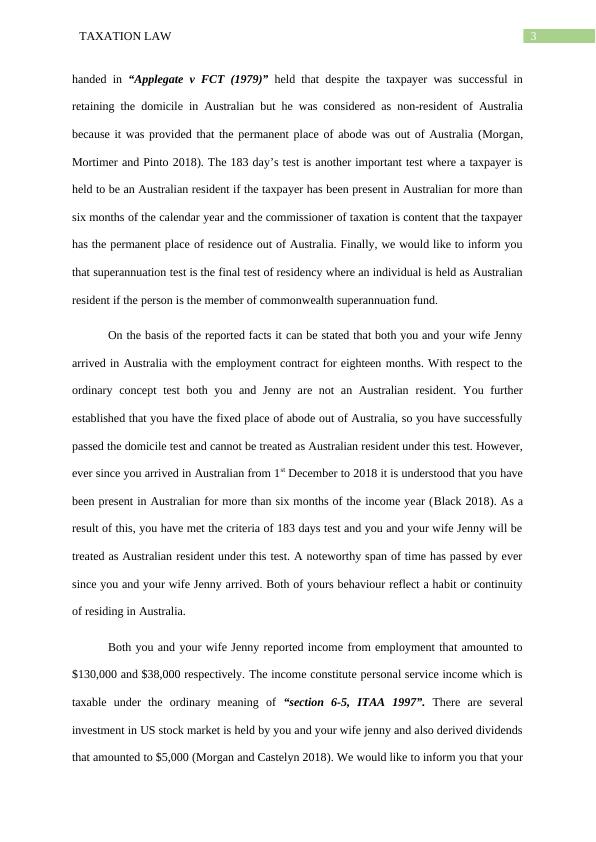Division 7A – Private Company Loans
18 Pages4909 Words59 Views
Added on 2023-01-23
About This Document
This article provides an overview of Division 7A of Taxation Law, focusing on private company loans. It discusses the scope of Division 7A, the need for its introduction, and the overall policy objectives. The article also evaluates whether Division 7A meets its objectives and suggests possible amendments. Expert advice on taxation law is provided.
Division 7A – Private Company Loans
Added on 2023-01-23
ShareRelated Documents
Running head: TAXATION LAW
Taxation Law
Name of the Student
Name of the University
Authors Note
Course ID
Taxation Law
Name of the Student
Name of the University
Authors Note
Course ID

1TAXATION LAW
Table of Contents
Part A:........................................................................................................................................2
Letter of Advice.........................................................................................................................2
Part B: Division 7A – Private Company Loans.........................................................................5
Introduction:...............................................................................................................................5
Scope of Division 7A:................................................................................................................5
The need for introducing Division 7A:......................................................................................6
Overall policy objectives of Division 7A:.................................................................................8
Evaluation of whether the Division 7 meets the policy objectives:...........................................9
Necessary further amendment to Division 7A:........................................................................10
New single Loan Model:......................................................................................................10
No formal written loan agreement.......................................................................................11
Grace Period for outstanding pre-1997 loans:.....................................................................11
Abolition of distributable surplus.........................................................................................11
Adoption of Unpaid present entitlements (UPEs):...............................................................12
Conclusion:..............................................................................................................................13
References:...............................................................................................................................14
Table of Contents
Part A:........................................................................................................................................2
Letter of Advice.........................................................................................................................2
Part B: Division 7A – Private Company Loans.........................................................................5
Introduction:...............................................................................................................................5
Scope of Division 7A:................................................................................................................5
The need for introducing Division 7A:......................................................................................6
Overall policy objectives of Division 7A:.................................................................................8
Evaluation of whether the Division 7 meets the policy objectives:...........................................9
Necessary further amendment to Division 7A:........................................................................10
New single Loan Model:......................................................................................................10
No formal written loan agreement.......................................................................................11
Grace Period for outstanding pre-1997 loans:.....................................................................11
Abolition of distributable surplus.........................................................................................11
Adoption of Unpaid present entitlements (UPEs):...............................................................12
Conclusion:..............................................................................................................................13
References:...............................................................................................................................14

2TAXATION LAW
Part A:
Letter of Advice
To Jenny and John
From Miller Tax Consultants
Date: 22-4-2019
Dear Jenny and John
The present letter of advice aims to address your residential status and income tax
consequences relating to the transactions that has been occurred by you and your wife Jenny.
As a primary note, we would like to make you aware that for income tax purpose an
Australian resident is required to pay tax on income earned from all the Australian sources
(Woellner et al. 2016). There are four types of residential status test however an individual is
only required to meet the criteria of one test to be treated as Australian resident under
“section 6 (1), ITAA 1997”.
We would like to inform you that the ordinary resides test is the primary test of
determining residential position of an individual. A person under the ordinary concept test is
held as Australian resident if he or she is actually living in Australia, regardless of their
citizenship or nationality. The taxation commissioner in “FCT v Miller (1946)” explained
that determining the residential status of an individual is based on the subject of fact
(Barkoczy 2016). Noteworthy factor such as the amount of time that is spend living in
Australia is held vital.
The domicile test is another test of residency where a person is held as Australian
resident if their domicile or place of abode is in Australian and the commissioner of taxation
is satisfied that their domicile is foreign country (Sadiq 2018). The federal court judgement
Part A:
Letter of Advice
To Jenny and John
From Miller Tax Consultants
Date: 22-4-2019
Dear Jenny and John
The present letter of advice aims to address your residential status and income tax
consequences relating to the transactions that has been occurred by you and your wife Jenny.
As a primary note, we would like to make you aware that for income tax purpose an
Australian resident is required to pay tax on income earned from all the Australian sources
(Woellner et al. 2016). There are four types of residential status test however an individual is
only required to meet the criteria of one test to be treated as Australian resident under
“section 6 (1), ITAA 1997”.
We would like to inform you that the ordinary resides test is the primary test of
determining residential position of an individual. A person under the ordinary concept test is
held as Australian resident if he or she is actually living in Australia, regardless of their
citizenship or nationality. The taxation commissioner in “FCT v Miller (1946)” explained
that determining the residential status of an individual is based on the subject of fact
(Barkoczy 2016). Noteworthy factor such as the amount of time that is spend living in
Australia is held vital.
The domicile test is another test of residency where a person is held as Australian
resident if their domicile or place of abode is in Australian and the commissioner of taxation
is satisfied that their domicile is foreign country (Sadiq 2018). The federal court judgement

3TAXATION LAW
handed in “Applegate v FCT (1979)” held that despite the taxpayer was successful in
retaining the domicile in Australian but he was considered as non-resident of Australia
because it was provided that the permanent place of abode was out of Australia (Morgan,
Mortimer and Pinto 2018). The 183 day’s test is another important test where a taxpayer is
held to be an Australian resident if the taxpayer has been present in Australian for more than
six months of the calendar year and the commissioner of taxation is content that the taxpayer
has the permanent place of residence out of Australia. Finally, we would like to inform you
that superannuation test is the final test of residency where an individual is held as Australian
resident if the person is the member of commonwealth superannuation fund.
On the basis of the reported facts it can be stated that both you and your wife Jenny
arrived in Australia with the employment contract for eighteen months. With respect to the
ordinary concept test both you and Jenny are not an Australian resident. You further
established that you have the fixed place of abode out of Australia, so you have successfully
passed the domicile test and cannot be treated as Australian resident under this test. However,
ever since you arrived in Australian from 1st December to 2018 it is understood that you have
been present in Australian for more than six months of the income year (Black 2018). As a
result of this, you have met the criteria of 183 days test and you and your wife Jenny will be
treated as Australian resident under this test. A noteworthy span of time has passed by ever
since you and your wife Jenny arrived. Both of yours behaviour reflect a habit or continuity
of residing in Australia.
Both you and your wife Jenny reported income from employment that amounted to
$130,000 and $38,000 respectively. The income constitute personal service income which is
taxable under the ordinary meaning of “section 6-5, ITAA 1997”. There are several
investment in US stock market is held by you and your wife jenny and also derived dividends
that amounted to $5,000 (Morgan and Castelyn 2018). We would like to inform you that your
handed in “Applegate v FCT (1979)” held that despite the taxpayer was successful in
retaining the domicile in Australian but he was considered as non-resident of Australia
because it was provided that the permanent place of abode was out of Australia (Morgan,
Mortimer and Pinto 2018). The 183 day’s test is another important test where a taxpayer is
held to be an Australian resident if the taxpayer has been present in Australian for more than
six months of the calendar year and the commissioner of taxation is content that the taxpayer
has the permanent place of residence out of Australia. Finally, we would like to inform you
that superannuation test is the final test of residency where an individual is held as Australian
resident if the person is the member of commonwealth superannuation fund.
On the basis of the reported facts it can be stated that both you and your wife Jenny
arrived in Australia with the employment contract for eighteen months. With respect to the
ordinary concept test both you and Jenny are not an Australian resident. You further
established that you have the fixed place of abode out of Australia, so you have successfully
passed the domicile test and cannot be treated as Australian resident under this test. However,
ever since you arrived in Australian from 1st December to 2018 it is understood that you have
been present in Australian for more than six months of the income year (Black 2018). As a
result of this, you have met the criteria of 183 days test and you and your wife Jenny will be
treated as Australian resident under this test. A noteworthy span of time has passed by ever
since you and your wife Jenny arrived. Both of yours behaviour reflect a habit or continuity
of residing in Australia.
Both you and your wife Jenny reported income from employment that amounted to
$130,000 and $38,000 respectively. The income constitute personal service income which is
taxable under the ordinary meaning of “section 6-5, ITAA 1997”. There are several
investment in US stock market is held by you and your wife jenny and also derived dividends
that amounted to $5,000 (Morgan and Castelyn 2018). We would like to inform you that your

End of preview
Want to access all the pages? Upload your documents or become a member.
Related Documents
Taxation Law: Deductions and Residency Statuslg...
|18
|4855
|138
Taxation Lawlg...
|9
|1321
|54
Determining Australian residency status under subsection 6(1) of ITAA 1997lg...
|7
|1588
|210
Determining Tax Residency Status under ITAA 1997lg...
|6
|1408
|243
Taxation Law: Residency, Income, and Deductionslg...
|22
|6271
|388
Taxation Law: Letter of Advicelg...
|9
|1379
|21
